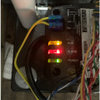optimizing eer and seer ratings
My sole concern is saving you money, in every possible way that I can, on your utility bills!
First, always do what you can to reduce the Heat-gain/heat/loss.
KEEP YOUR INITIAL A/C EQUIPMENT INVESTMENT in line with your Climate Zone conditions.
Get what you paid for, always thoroughly seal and optimize the duct system! Your 3-ton equipment could only delivering 1.5-ton of cooling into your home.
New equipment will NOT automatically deliver their SEER efficiency Rating & BTUH Rating. "Typically, for many reasons, installed equipment only operates at 55% to 70% of Rated Capacity." We can change that equation!
"Over half of the system’s efficiency depends on the duct system and the field-installation."
Optimizing EER and SEER Ratings
First, let us look at seer ratings.
The most important factors in seer ratings is the proper sizing of the equipment so that it reduces the number of run cycles per hour, per day and per season.
There are some components that will it help elevate the SEER Ratings.
1. First, is a variable speed and CFM control air handler.
2. Second, is an evaporator coil with a thermostatic expansion valve (TXV).
3. Third, it is A room thermostat (T'stat) with an adjustable on/off set point temperature differential.
4. Fourth, is to utilize a large 20-inch floor fan to circulate the air when the unit is off.
SEER Payback needs to be Properly Represented to Consumers
The SEER ratings are too nebulous & do not translate to the specific application conditions that each consumer will normally have. EER is simpler & more reliable when the systems are correctly sized to the load.
The SEER of a system is determined by multiplying the steady state energy efficiency ratio (EER) measured at conditions of 82°F outdoor temperature, 80°F dB and 67°F WB indoor entering air temperature by the Part Load Factor (PLF) of the system. (The PLF is supplied by the government.)
The SEER rating is at a particular set of conditions that are NOT typical design, or at your particular climate zone conditions.
Summer Outdoor Design varies however, we usually design for 75°F indoors NOT 80°F, also when systems' are downsized properly to achieve long runtimes the Part Load Factor becomes far less of a factor.
Always go by the EER Rating NOT the SEER rating because, as the SEER goes higher the EER ratio to it drops. Therefore, when the system is sized properly you have a lot more steady-state continuous runtime cycles & the Part Load Factor (PLF) will be minimized.
The PLF figures in the cyclical start-ups, whereby it takes 5 to 7 minutes or more to reach full operating capacity.
"During average operating conditions in its particular environment, I want to peak-load the evaporator at near its BTUH Rating."
Keeping the evaporator near peak load conditions at 76-F Room Temp will Optimize the Condenser BTUH Heat Load Output.
Adjustable Thermostatic Expansion Valves (TEV/TXV) systems could be set for 10F Superheat, or usually a minimum of 8F-Degrees Superheat in Humid Climates. - udarrell
Here is a link that might be useful: ENGINEERING For The HUMAN COMFORT ZONE





ryanhughes
garyg
Related Discussions
seer/eer check, please.
Q
amana 14 seer 3.5 ton or trane 15 seer 4 ton???
Q
a/c seer vs eer
Q
savings of 14 seer vs 16 seer
Q
ryanhughes
udarrell_2007Original Author